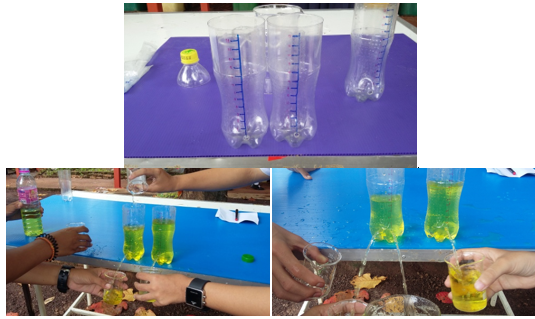Eleventh grade students’ conceptual understanding and mental models on chemical equilibrium from learning by using inquiry incorporated with predict-observe-explain technique
Main Article Content
Abstract
The main purpose of this research was to investigate eleventh grade students’ conceptual understanding in chemical equilibrium from learning by using inquiry incorporated with predict-observe-explain learning technique for 10 hours. The data collecting tools consisted of 2-tier diagnostic conceptual test and mental model test. The dependent samples t-test analysis of students’ conceptual test scores indicated that the post-conceptual test score (mean 19.32, S.D. 6.09) was significantly higher than the pre-conceptual test score (mean 8.06, S.D. 3.21) at the 95% confidence level. After the implementation, the total percentages of students in no- and mis-conceptual understanding (NU+MU) categories decreased by 29.01, while the total percentage of students in the sound and partial conceptual understanding (SU+PU) categories increased by 32.72. The mental model analysis revealed that the total percentage of students’ mental model in no- and mis-conceptual understanding (NU+MU) categories was 15.55 and the total percentage of students in the sound and partial conceptual understanding (SU+PU) categories was 68.89. This verified that this implementation was effective to develop students’ conceptual understanding of chemical equilibrium.
Article Details
The Journal of Science and Science Education (JSSE) retain the right of all articles published in JSSE. The coresponding author or the authorized person on behalf of the authors must send the complete Copyright Transfer Form to JSSE before any article get published in JSSE.
Copyright Transfer Form
The JSSE request the coresponding author or the authorized person on behalf of the authors upload the manuscript under the together with the Copyright Transfer Form under the supplementary data. The guidline for uploading both manuscript and Copyright Transfer Form is shown below:
1. Upload the manuscript in the sub-menu, Article Component > Article Text.
2. Upload the the Copyright Transfer Form in the sub-menu, Article Component > Other.
Download Copyright Transfer Form
References
ชาตรี ฝ่ายคำตา. (2551). แนวคิดทางเลือกของนักเรียนในวิชาเคมี. วารสารศึกษาศาสตร์ หาวิทยาลัยสงขลา-นครินทร์ วิทยาเขตปัตตานี, 19(2), 10-25.
ทัศวรรณ ภูผาดแร่ และศักดิ์ศรี สุภาษร. (2557). การพัฒนาผลสัมฤทธิ์ทางการเรียนเรื่อง สารชีวโมเลกุล โดยใช้กิจกรรมการเรียนรู้แบบสืบเสาะทางวิทยาศาสตร์ร่วมกับกิจกรรมทำนาย-สังเกต-อธิบาย. ในรายงานสืบเนื่องการประชุมวิชาการระดับชาติวิทยาศาสตร์วิจัย ครั้งที่ 6 (หน้า 1-6). ชลบุรี: มหาวิทยาลัยบูรพา.
พนิดา กันยะกาญจน์ และศักดิ์ศรี สุภาษร. (2557). การจัดการเรียนรู้แบบสืบเสาะร่วมกับแบบเปรียบเทียบเพื่อพัฒนามโนมติทางวิทยาศาสตร์ เรื่อง อัตราการเกิดปฏิกิริยาเคมี ของนักเรียนชั้นมัธยมศึกษาปีที่ 5. ในรายงานสืบเนื่องจากการประชุมวิชาการระดับชาติวิทยาศาสตร์วิจัย ครั้งที่ 6 (หน้า 26-31). ชลบุรี: มหาวิทยาลัยบูรพา.
ภรทิพย์ สุภัทรชัยวงศ์ ชาตรี ฝ่ายคำตา และพจนารถ สุวรรณรุจิ. (2558). การจัดการเรียนรู้โดยใช้แบบจำลองเป็นฐานเพื่อพัฒนาแบบจำลองทางความคิด เรื่องโครงสร้างอะตอมและความเข้าใจธรรมชาติของแบบจำลองของนักเรียนชั้นมัธยมศึกษาปีที่ 4. วารสารนวัตกรรมการเรียนรู้ มหาวิทยาลัยวลัยลักษณ์, 1(1), 97-124.
วิจารณ์ พานิช. (2555). วิธีการสร้างการเรียนรู้เพื่อศิษย์ในศตวรรษที่ 21. กรุงเทพฯ: โรงพิมพ์บริษัทตถาตา พับลิเคชั่น.
วิทยา ภาชื่น และไพศาล สุวรรณน้อย. (2553). การศึกษาผลการจัดการเรียนรู้โดยใช้การเปรียบเทียบเพื่อส่งเสริมการเปลี่ยนแปลงมโนมติ เรื่องสมดุลเคมีของนักเรียนชั้นมัธยมศึกษาปีที่ 5. วารสารศึกษาศาสตร์ ฉบับวิจัยบัณฑิตศึกษามหาวิทยาลัยขอนแก่น, 4(พิเศษ), 1-17.
ศักดิ์ศรี สุภาษร. (2555). บทบาทของเมนทอลโมเดลในการเรียนรู้วิชาเคมีระดับโมเลกุล. วารสารศึกษาศาสตร์ มหาวิทยาลัยขอนแก่น, 35(1), 1-7.
ศักดิ์ศรี สุภาษร นุจรี สุภาษร วรรณวไล อธิวาสน์พงศ์ และสนธิ พลชัยยา. (2559). การพัฒนาความเข้าใจมโนมติ เรื่อง สารละลาย ด้วยการทดลองแบบสืบเสาะร่วมกับภาพเคลื่อนไหวระดับอนุภาค สำหรับนักเรียนระดับมัธยมศึกษาปีที่ 2. วารสารหน่วยวิจัยวิทยาศาสตร์ เทคโนโลยี และสิ่งแวดล้อมเพื่อการเรียนรู้, 7(1), 28-47.
สถาบันส่งเสริมการสอนวิทยาศาสตร์และเทคโนโลยี. (2549). การจัดการเรียนรู้แบบสืบเสาะ. กรุงเทพมหานคร: โรงพิมพ์คุรุสภาลาดพร้าว.
อรพินทร์ ชูชม. (2552). การวิจัยกึ่งทดลอง. วารสารพฤติกรรมศาสตร์, 15(1), 1-15.
ฮิกมะฮ์ อาแวกะจิ และศักดิ์ศรี สุภาษร. (2558). การพัฒนาความเข้าใจมโนมติวิทยาศาสตร์ เรื่องสมดุลเคมี ด้วยวัฏจักรการเรียนรู้แบบสืบเสาะ 5 ขั้น ผสมผสานกับเทคนิคทำนาย-สังเกต-อธิบายในขั้นขยายความรู้ สำหรับนักเรียนชั้นมัธยมศึกษาปีที่ 5. ในรายงานสืบเนื่องการประชุมวิชาการ ม.อบ. วิจัย ครั้งที่ 9 (หน้า 388-398). อุบลราชธานี: มหาวิทยาลัยอุบลราชธานี.
Hompromma, A. and Suwannoi, P. (2010). Grade 10 Thai students’ analogy for explaining rate of reaction. In Proceeding of the 41st Australasian Science Education Research Association (pp. 40-45). New South Wales, Australia: Dave Palmer.
Eilks, I. and Gulacar, O. (2016). A colorful demonstration to visualize and inquire into essential elements of chemical equilibrium. Journal of Chemical Education, 93(11), 1904-1907.
Turner, K.L. (2016). A cost effective physical modeling exercise to develop students' understanding for covalent bonding. Journal of Chemical Education, 93(6), 1073-1080.
Kelly, R.M. and Akaygun, S. (2016). Insights into how students learn the difference between a weak acid and a strong acid from cartoon tutorials employing visualizations. Journal of Chemical Education, 93(6), 1010-1019.
Supasorn, S. (2015). Grade 12 students’ conceptual understanding and mental models of galvanic cells before and after learning by using small-scale experiments in conjunction with a model kit. Chemistry Education Research and Practice, 16(2), 393-407.


